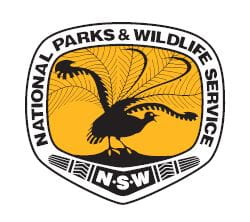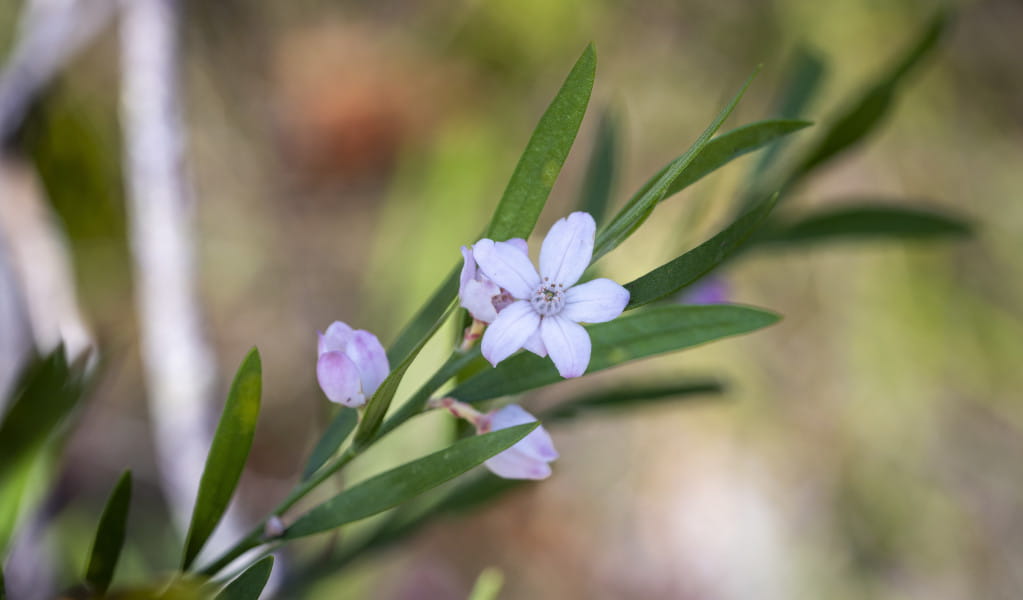Muogamarra Peats Bight walk
Muogamarra Nature Reserve
Overview
SOLD OUT. On this challenging 10km full-day walk in Muogamarra Nature Reserve, near Cowan, you'll hear about Peats Crater's amazing geological features.
- When
Tour time: 9.30am to 3.30pm. Meet at 9am.
Tour dates: Saturday 17 August, Friday 23 August, Friday 30 August, Saturday 31 August, Monday 2 September, Monday 9 September and Friday 20 September 2024.
- Accessibility
- No wheelchair access
- Grade
- Hard. Suitable for adults and children, 15 years and over. Some bushwalking experience is recommended. Tracks may have short steep hill sections, a rough surface and many steps.
- Price
-
SOLD OUT. Adult $55 per person. Concession (Student, Australian pension, Veterans Affairs and Seniors card holders) $50 per person.
- Entry fees
- Price includes park entry fee
- Meeting point
- Muogamarra visitor centre.
- Bookings
SOLD OUT.
- Please note
- You can only visit Muogamarra Nature Reserve if you have booked a guided tour in advance.
- You can only access this track at the tour times.
- It is 3km from the park gate to the visitor centre, so please allow for this in your travel time.
- Please check for ticks and leeches at the end of the walk.
- Supervise children near lookouts and clifftops with no barriers.
- Muogamarra Nature Reserve protects a fragile ecosystem so let’s keep it plastic free.
We'll begin at the visitor centre and walk to Peats Crater. From there we'll continue on to Peats Bight along an historic road that was constructed by bonded convicts.
On this walk you'll discover fascinating geological features in the landscape around you. Your guide will point out picturesque Hawkesbury sandstone and impressive volcanic pipes filled with solidified magma. Keep an eye out for historic relics, such as Peats Bight Guest House, early wharves and retaining walls.
You'll also walk through lush rainforest and mangrove environments. Once we reach Peats Bight, you can relax and enjoy the views along Berowra Creek and the Hawkesbury River. You'll begin to appreciate the preservation of the area and understand why it was listed as a sanctuary in 1935.
Muogamarra Nature Reserve is open for just 6 weekends a year to preserve its fragile ecosystems and Aboriginal heritage.
Bring drinking water, morning tea and lunch. Wear sunscreen, insect repellant, sturdy walking shoes, hat and consider bringing walking poles if needed.
Found out more about the 90-year history of Muogamarra Nature Reserve.
Local alerts
For the latest updates on fires, closures and other alerts in this area, see https://www.nationalparks.nsw.gov.au/things-to-do/guided-tours/muogamarra-peats-bight-walk/local-alerts
Bookings
- National Parks Contact Centre
- 7am to 7pm daily
- 1300 072 757 (13000 PARKS) for the cost of a local call within Australia excluding mobiles
- parks.info@environment.nsw.gov.au
Operated by

- NSW National Parks & Wildlife Service
Park info
- in Muogamarra Nature Reserve in the Sydney and surrounds region
Muogamarra Nature Reserve is open to the public from 9am to 4.30pm for 6 weeks around August and September each year. The reserve will open from Saturday 17 August to Sunday 22 September 2024. The reserve is closed to the public at other times to protect sensitive natural and cultural heritage values.
Visitor info
All the practical information you need to know about Muogamarra Peats Bight walk.
Getting there and parking
Get driving directions
From Sydney:
- Head north towards Newcastle on the F3 Freeway and take the Berowra exit
- Turn right onto Pacific Highway and follow it past Cowan
- The park entrance is on your left, approximately 3km north of Cowan.
From Gosford/Newcastle:
- Head south on the F3 Freeway and take the Mooney Mooney exit
- Follow Old Pacific Highway across the Hawkesbury River towards Cowan
- The park entrance is on your right, approximately 6km from the freeway exit.
Parking
Parking limited, so please car pool where possible. Buses and trailers not admitted because the road is unsuitable for heavy vehicles.
Maps and downloads
Accessibility
Disability access level - no wheelchair access
Not wheelchair-accessible.
Learn more
Muogamarra Peats Bight walk is in Muogamarra Nature Reserve. Here are just some of the reasons why this park is special:
A snapshot of colonial times gone by

You'll also find remnants of colonial history at Muogamarra. During the 1830s and 1840s, several roads were built throughout the area, providing vital transport routes between Sydney and the Hawkesbury River. Remains of dry stone walls, culverts and foundations of earlier buildings can be found in the reserve.
- Muogamarra highlights walk Join this 3km guided walk in Muogamarra Nature Reserve, near Cowan. You'll learn about John Tipper's foresight in securing this beautiful area for future generations. We'll stop at some amazing views.
- Muogamarra Lloyd Trig and Deerubbin loop walk SOLD OUT. Enjoy this 6.6km guided walk to Deerubbin lookover via Lloyd Trig. Discover extraordinary places above sea level, with spectacular views out to the Hawkesbury River.
- Muogamarra Peats Bight walk SOLD OUT. On this challenging 10km full-day walk in Muogamarra Nature Reserve, near Cowan, you'll hear about Peats Crater's amazing geological features.
Fascinating landscapes

Hawkesbury sandstone is the most common geological feature found within Muogamarra Nature Reserve and forms the extensive plateau on which you'll explore. Impressive volcanic pipes filled with solidified magma (a type of diatreme) can also be found at Peats Crater and Peats Bight. The volcanic rocks from these diatremes house a striking deep red soil which is rich in nutrients and fantastic nourishment for the plants which grow here.
- Muogamarra Lloyd Trig and Deerubbin loop walk SOLD OUT. Enjoy this 6.6km guided walk to Deerubbin lookover via Lloyd Trig. Discover extraordinary places above sea level, with spectacular views out to the Hawkesbury River.
- Muogamarra Peats Bight walk SOLD OUT. On this challenging 10km full-day walk in Muogamarra Nature Reserve, near Cowan, you'll hear about Peats Crater's amazing geological features.
Rich in Aboriginal significance

The Aboriginal people of Muogamarra Country lived in the area for at least 20,000 years prior to European settlement, making extensive use of the Hawkesbury River and adjacent ridgelines. Evidence of Aboriginal heritage can be seen in engravings and shell middens found throughout the reserve. Discover the significance of Muogamarra to Aboriginal people today on a Muogamarra Indigenous heritage walk.
- Muogamarra Bird Gully walk SOLD OUT. Walk 3.5km along Bird Gully track around the edge of a hanging swamp in Muogamarra Nature Reserve, near Cowan. Bring your camera. You'll want to photograph the gorgeous flowers in this amazing reserve.
- Muogamarra highlights walk Join this 3km guided walk in Muogamarra Nature Reserve, near Cowan. You'll learn about John Tipper's foresight in securing this beautiful area for future generations. We'll stop at some amazing views.
- Muogamarra Lloyd Trig and Deerubbin loop walk SOLD OUT. Enjoy this 6.6km guided walk to Deerubbin lookover via Lloyd Trig. Discover extraordinary places above sea level, with spectacular views out to the Hawkesbury River.
- Muogamarra self-guided tour Explore Muogamarra Nature Reserve, near Cowan in Sydney's north, on a self-guided tour during its open season. Book now to visit this reserve and discover its beauty at your own pace.
The language of wildflowers

For plant lovers, it’s hard to find an area so diverse in unique plant life. There are over 900 plant species found in Muogamarra – an extraordinary amount given its relatively small size and proximity to the city. The spring wildflower displays will dazzle visitors with their bright colours. Get up close and see beautiful displays of native orchids, bright pink eriostemons, pink boronias and towering Gymea lilies. With such beautiful surroundings, it’s no wonder so many native animals make their home at Muogamarra. 14 species of native mammals, including the swamp wallaby, brush tail possum and echidna reside here. Also, 16 reptile species and 140 native birds have been recorded in the area. Spend a day exploring while listening to the laughing calls of the kookaburra and see if you can spot some wildlife on the trail ahead.
- Muogamarra Bird Gully walk SOLD OUT. Walk 3.5km along Bird Gully track around the edge of a hanging swamp in Muogamarra Nature Reserve, near Cowan. Bring your camera. You'll want to photograph the gorgeous flowers in this amazing reserve.
- Muogamarra highlights walk Join this 3km guided walk in Muogamarra Nature Reserve, near Cowan. You'll learn about John Tipper's foresight in securing this beautiful area for future generations. We'll stop at some amazing views.
- Muogamarra Peats Bight walk SOLD OUT. On this challenging 10km full-day walk in Muogamarra Nature Reserve, near Cowan, you'll hear about Peats Crater's amazing geological features.
- Muogamarra self-guided tour Explore Muogamarra Nature Reserve, near Cowan in Sydney's north, on a self-guided tour during its open season. Book now to visit this reserve and discover its beauty at your own pace.
Plants and animals protected in this park
Animals
-

Common brushtail possum (Trichosurus vulpecula)
One of the most widespread of Australian tree-dwelling marsupials, the common brushtail possum is found across most of NSW in woodlands, rainforests and urban areas. With strong claws, a prehensile tail and opposable digits, these native Australian animals are well-adapted for life amongst the trees.
Plants
-

Waratah (Telopea speciosissima)
The beautiful waratah is not only the NSW floral emblem, it's also one of the best-known Australian native plants. This iconic Australian bush flower can be found on sandstone ridges around Sydney, in nearby mountain ranges and on the NSW South Coast. The waratah has a vibrant crimson flowerhead, measuring up to 15cm across, and blossoms in spring.
-

Scribbly gum (Eucalyptus haemastoma)
Easily identifiable Australian native plants, scribbly gum trees are found throughout NSW coastal plains and hills in the Sydney region. The most distinctive features of this eucalypt are the ‘scribbles’ made by moth larva as it tunnels between the layers of bark.
-

Old man banksia (Banksia serrata)
Hardy Australian native plants, old man banksias can be found along the coast, and in the dry sclerophyll forests and sandstone mountain ranges of NSW. With roughened bark and gnarled limbs, they produce a distinctive cylindrical yellow-green banksia flower which blossoms from summer to early autumn.
-

Grey mangrove (Avicennia marina)
Grey mangrove is the most common and widespread mangrove found within intertidal zones across Australia, and throughout the world. Growing to a height of 3-10m, they thrive best in estuaries with a mix of fresh and salt water. They excrete excess salt through their long thick leaves, and absorb oxygen through their aerial root system.

